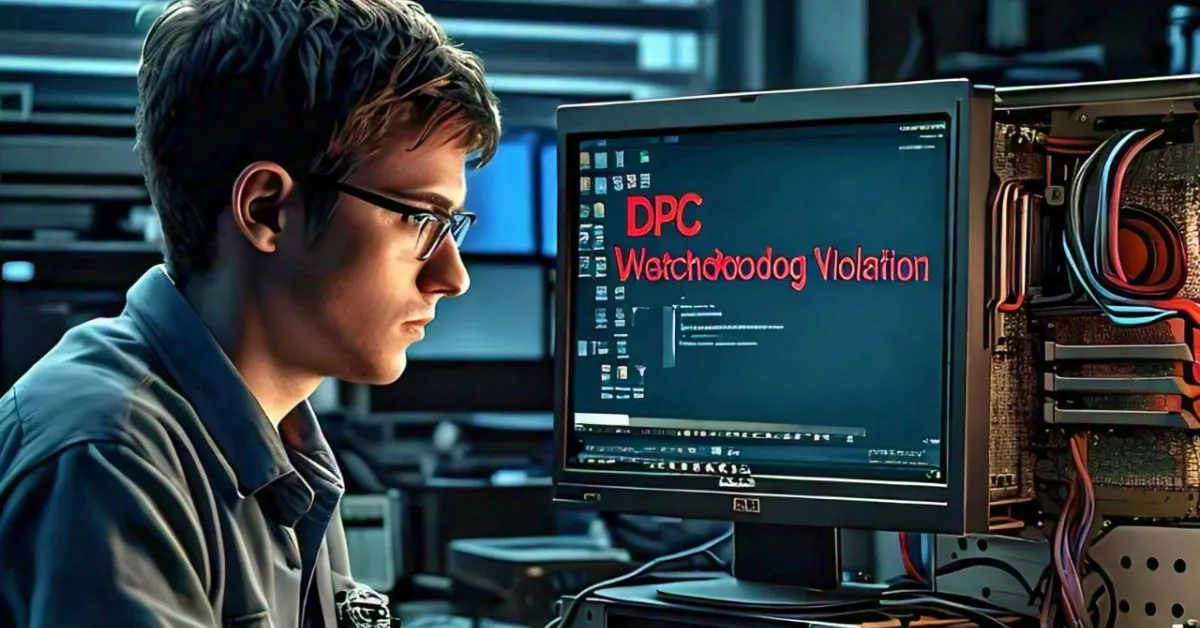The DPC Watchdog Violation Error is a frustrating blue screen error on Windows systems. While its name might sound complicated, the System’s watchdog (a monitoring utility) has detected a problem with the Deferred Procedure Call (DPC) process. When this happens, Windows can no longer continue operating, resulting in a crash and the dreaded Blue Screen of Death (BSOD). This error can disrupt work or gaming sessions and is usually triggered by underlying issues.
In this article, we’ll break down the DPC Watchdog Violation, why it happens, and how to fix it using simple, actionable steps.
What is a DPC Watchdog Violation?
The operating System uses the Deferred Procedure Call (DPC) process to prioritize essential tasks while delaying less critical ones. The watchdog is a system utility that monitors these processes. If the watchdog detects that a DPC is taking too long to complete, it assumes there’s an issue, leading to a violation. This results in a blue screen crash to prevent further damage or malfunction.
Common Causes of the DPC Watchdog Violation Error
Several factors can trigger the violation error. Understanding the common causes will help pinpoint the source of the issue:
Outdated or Corrupt Drivers
Faulty drivers, especially those for SSD drives or graphics cards, are often responsible for this error. When drivers are outdated or corrupt, they can interfere with the regular operation of the DPC process, causing a violation.
Incompatible or Failing Hardware
Newly installed hardware, such as external hard drives or USB devices, might not be fully compatible with the System. Additionally, faulty or malfunctioning hardware can lead to conflicts and errors, including DPC Watchdog Violations.
Corrupted System Files
Windows relies on core system files to function properly. If these files become corrupted or missing, it can cause various system errors, including watchdog violations.
External Devices
Sometimes, the issue is not with the System but with connected peripherals like printers, USB devices, or external hard drives. Incompatible or malfunctioning devices can lead to conflicts that trigger this error.
Solutions to Fix the Violation Error
Here are several methods you can use to troubleshoot and resolve the DPC Watchdog Violation error:
Remove External Devices
Start by disconnecting all external devices, including printers, drives, and USB peripherals. Restart the system to check if the error still occurs. If removing external devices resolves the issue, it likely indicates that one of the peripherals is causing the problem.
Update Drivers
Drivers are a frequent culprit for this error, especially those related to your SSD or graphics card. To update drivers:
- Open Device Manager by pressing Windows + X and selecting it from the menu.
- Expand the category for the device (e.g., Display adapters or Disk drives) that might be causing issues.
- Right-click on the device and select Update Driver. Choose Search automatically for updated driver software to find the latest version.
Alternatively, you can visit the manufacturer’s website (e.g., NVIDIA for graphics cards or your SSD provider) to manually download and install the latest drivers.
Change SATA AHCI Controller Driver
If the problem is related to your SSD, updating the SATA AHCI Controller may resolve the issue:
- Open Device Manager and expand IDE ATA/ATAPI Controllers.
- Right-click on SATA AHCI Controller and choose Update Driver.
- Select Browse my computer for driver software, then choose Let me pick from a list of available drivers on my computer.
- Choose Standard SATA AHCI Controller from the list and click Next.
Once the update is complete, restart your computer and check if the issue is resolved.
Run System File Checker (SFC)
The System File Checker tool scans and repairs corrupted system files:
- Open Command Prompt as an administrator by typing cmd in the search bar, right-clicking on Command Prompt, and selecting Run as administrator.
- In the command window, type the following command and press Enter:
| Copy code |
| sfc /scannow |
The tool will scan your system files and automatically fix any corrupted or missing ones.
Check Disk for Errors
Problematic drive errors can also lead to system crashes. To check for disk errors, follow these steps:
- Open Command Prompt as an administrator.
- Type the following command and press Enter:
| Copy code |
| chkdsk C: /f |
This command will scan your C: drive for errors and attempt to fix them. Restart your System once the scan is complete.
Update SSD Firmware
Outdated SSD firmware is another common cause of the DPC Watchdog Violation error. To update the firmware:
- Visit the SSD manufacturer’s website and look for firmware updates.
- Follow their instructions to download and install the latest version.
Updating your SSD firmware can improve compatibility with Windows and prevent errors.
Use System Restore
If the error started appearing after a recent change (such as a software installation or system update), using System Restore to revert your System to an earlier point in time may fix the problem:
- Press Windows + S, type System Restore and select Create a restore point.
- In the System Properties window, click on System Restore.
- Follow the prompts to choose a restore point from a time before the error started occurring.
Conclusion
The DPC Watchdog Violation is a standard but manageable blue screen error on Windows systems. It typically arises from outdated drivers, incompatible hardware, or corrupted system files. Following the steps outlined above, users can identify the root cause and resolve the issue without technical support. Keeping drivers updated, regularly checking for disk errors, and maintaining system files are essential for preventing future errors.
FAQs:
What are the best methods to update drivers automatically?
The best way to automatically update drivers is through Device Manager by selecting the Update Driver option. Third-party tools like Driver Booster or Driver Easy can also automatically detect and install the latest drivers for your System.
How can I identify if my newly installed hardware is causing the error?
Start by removing the newly installed hardware. If the error is resolved after removing the hardware, the new device will likely be incompatible with your System. You can also check the Device Manager for any error icons or warnings related to the device.
Are there any specific antivirus programs that commonly cause DPC Watchdog Violations?
Some antivirus software, particularly those that deeply integrate with the System (like McAfee or Norton), may occasionally interfere with system processes and cause this error. Temporarily disabling or uninstalling your antivirus program can help identify if it’s the source of the problem.
How do I change the SATA AHCI controller in Device Manager?
To change the SATA AHCI controller, open Device Manager, locate IDE ATA/ATAPI Controllers, right-click on SATA AHCI Controller, and select Update Driver. Follow the prompts to choose the Standard SATA AHCI Controller manually.
What steps should I follow to use System Restore to fix the error?
To use System Restore, open System Properties, click System Restore, and select a restore point when the System is functioning correctly. Follow the on-screen instructions to complete the process and restart your computer.
Top of Form
Bottom of Form

